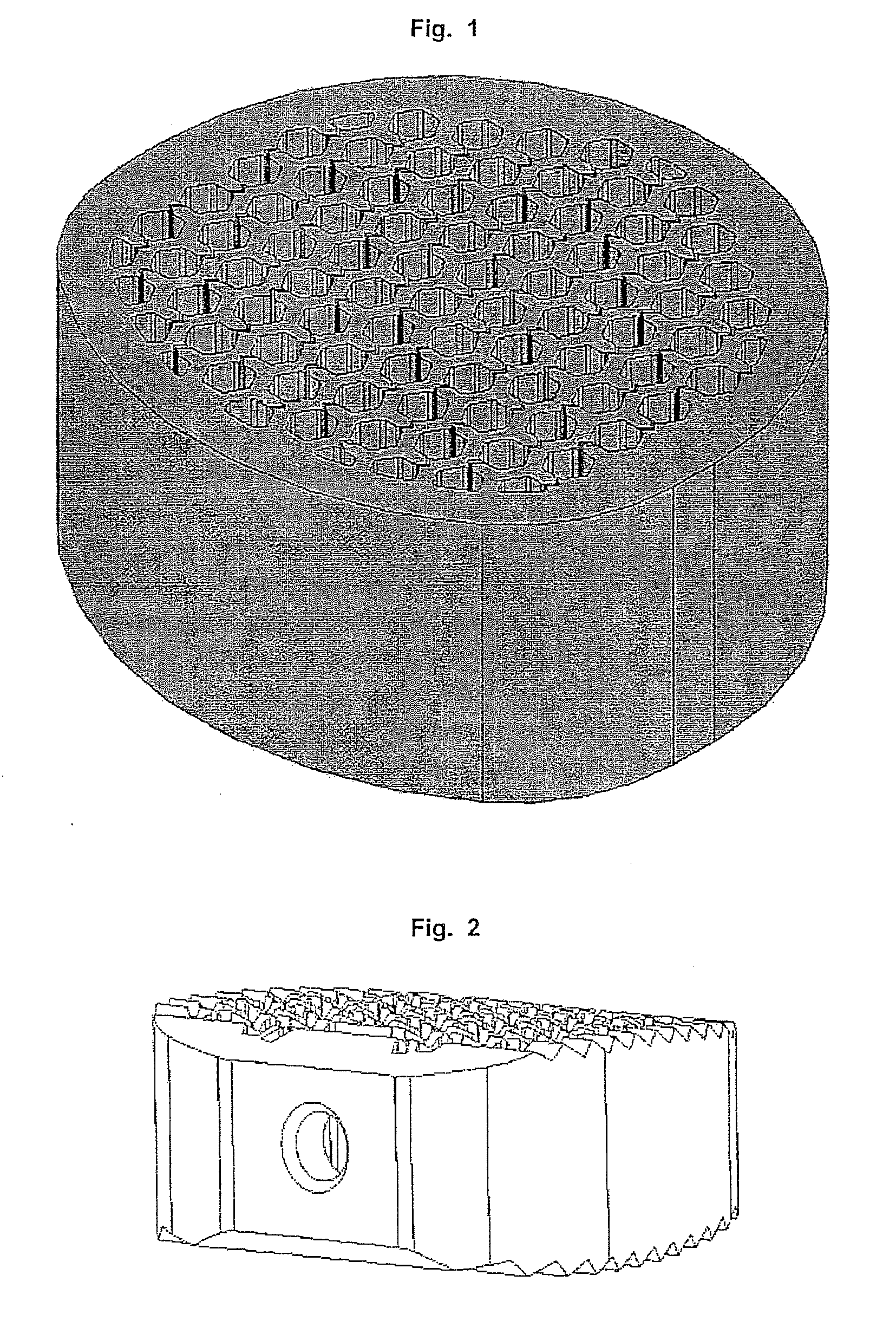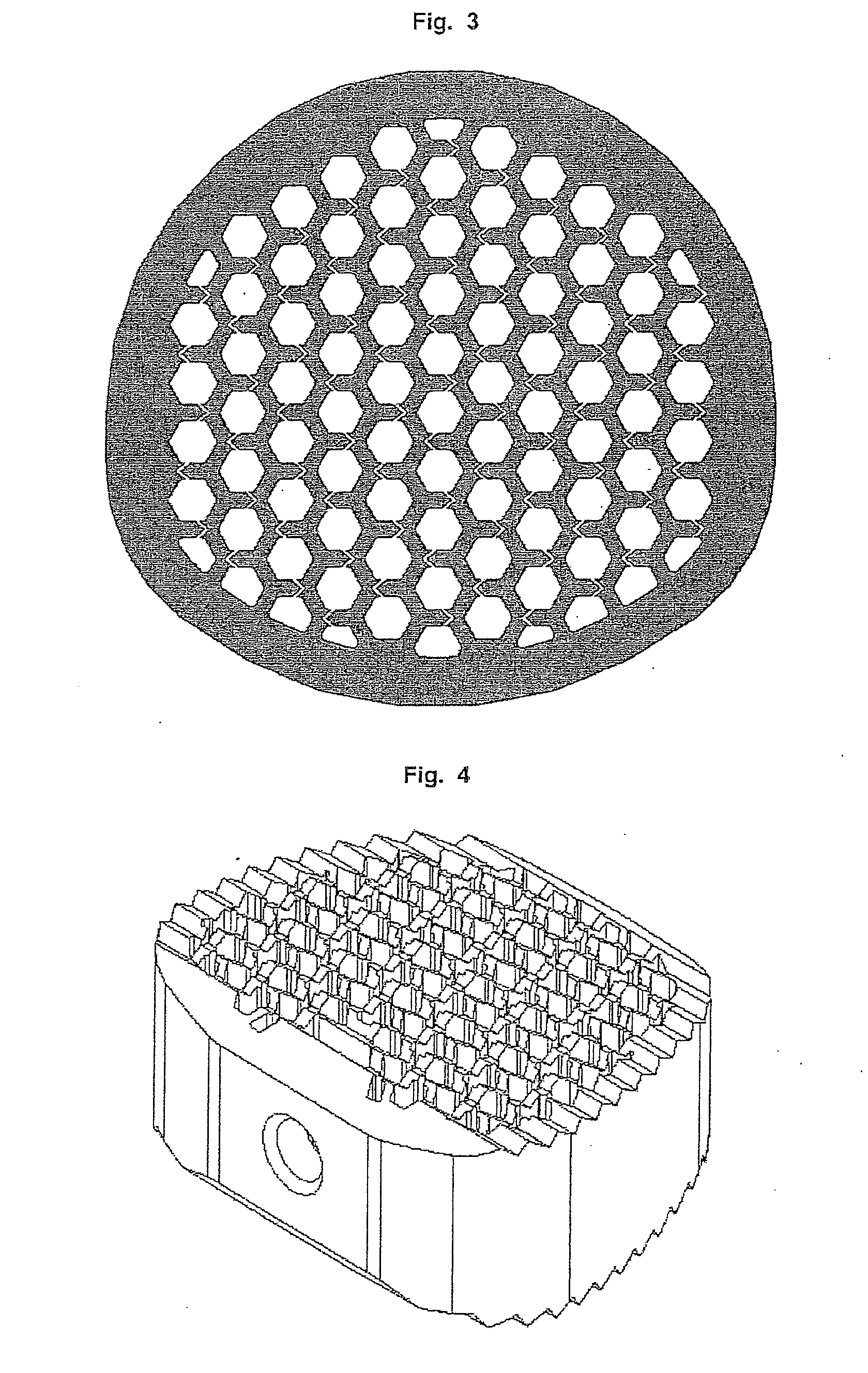Intervertebral implant
- Summary
- Abstract
- Description
- Claims
- Application Information
AI Technical Summary
Benefits of technology
Problems solved by technology
Method used
Image
Examples
example 1
Cage
[0168]Example 1 relates to a cage, especially a cervical cage with a longitudinal diameter of 14 mm and a transverse diameter of 12 mm and a height of 8 mm. The Cage is nearly oval and the longitudinal diameter is understood to be the maximum diameter and the transverse diameter is understood to be the smallest diameter.
[0169]The cage is made of titanium with a solid at least 1.1 mm thick outer sheath and an upper and lower flat surface for contact with the respective vertebral bodies.
[0170]Inside the cage a honeycomb structure of channels is formed with hexagonal walls. The channels extend in a straight line from the top of the bone-contacting surface to the opposite lower vertebral contacting flat surface. Per cm2 bone-contacting surface about 34-42 channels are available.
[0171]The channels have a diameter of 870-970 μm specified as the distance between two opposing parallel walls.
[0172]The channels are also connected with each other through notches in the channel walls. The n...
example 2
Cage
[0173]Example 2 relates to a cage, especially one with a cervical cage of longitudinal diameter 16 mm and a transverse diameter of 13 mm and a height of 9 mm. The cage is nearly oval and the longitudinal diameter is understood to be the maximum diameter and the transverse diameter is understood to be the smallest diameter.
[0174]The cage consists of zirconium with a massive 1.2 mm-thick outer sheath and an upper and lower surface for contact with the respective vertebral bodies. The upper edge of the outer sheath is flat and serves to support the upper vertebral body. The inner channel structure rises from the edge of the outer sheath in a convex shape up to 4 mm beyond the edge of the outer sheath, so that the channel structure in the middle of the cage can press up to 4 mm into the underside of the overlying vertebral body. On the opposite side of the cage the inner honeycomb or canal-type structure also extends like a spherical surface in a convex shape toward the upper surfac...
example 3
Cage
[0179]Example 3 relates to a cage, especially a thoracic cage with a longitudinal diameter of 10 mm and a transverse diameter of 8.8 mm and a height of 6.5 mm. The Cage is nearly oval and the longitudinal diameter is understood to be the maximum diameter and the transverse diameter is understood to be the smallest diameter.
[0180]The Cage consists of PEEK, which gets employed in medical technology, with a solid at least 0.9 mm thick outer sheath and an upper and lower flat surface for contact with the respective vertebral bodies, wherein the top and the bottom of the cage has been jagged or serrated with a height of the teeth of about 0.5 mm. Such shaped upper and lower surfaces are shown for example in FIG. 4 and FIG. 10.
[0181]Inside of the cage a channel-type structure is formed from channels with square walls. The channels extend in a straight line from the top of the upper vertebral body contacting surface to the opposite the other lower vertebral contacting surface. Per cm2 ...
PUM
 Login to View More
Login to View More Abstract
Description
Claims
Application Information
 Login to View More
Login to View More - R&D
- Intellectual Property
- Life Sciences
- Materials
- Tech Scout
- Unparalleled Data Quality
- Higher Quality Content
- 60% Fewer Hallucinations
Browse by: Latest US Patents, China's latest patents, Technical Efficacy Thesaurus, Application Domain, Technology Topic, Popular Technical Reports.
© 2025 PatSnap. All rights reserved.Legal|Privacy policy|Modern Slavery Act Transparency Statement|Sitemap|About US| Contact US: help@patsnap.com



